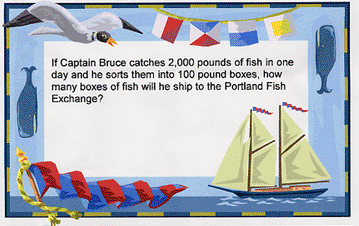

|
||||
Eva Hoyt Zippel School, Presque Isle, ME and F/V Seandrea II, So. Bristol, ME
Bruce Morton has, as usual, started our year off well. He has gotten my class excited about what is happening on the coast of Maine. He started the year by e-mailing the class some pictures of colored lobsters that had been caught in his area. He has answered several questions via e-mailso far. One of the e-mails talked about what kinds of fishing he does and how much he enjoys shrimping. This sparked an interest in my students to find out more about shrimping in Maine. In the process of finding out about shrimping, one of the students read an article about sea squirts in the Gulf of Maine. This sent the students back to Captain Bruce to find out if they have affected his fishing. When they discovered that this was not the case, we expanded the lesson to look at what a sea squirt is and who is affected by them. The class is currently doing its research thanks to MIT Sea Grant's Adopt-A-Boat and the web sites you sent to us. A second project we are doing is what has become known as our board story. One of our building's custodians is very artistic. Each year he creates a series of pictures that the students write about. It becomes a class story and always involves an adventure of Captain Bruce. This is the third year in a row that we have done a board story. The students do not know what the next picture will be so they cannot continue the story until it appears on our board. It is a great project and has helped show the class how to use what they know to be true to make a better fictional story. I also use the board story to teach punctuation and clear communication. Students must always end the story in a way that makes the reader want to find out what happens next. Board story, chapter 1 (MSWord document) Board story, chapter 2 (MSWord document) Board story, chapter 3 (MSWord document) Board story, chapter 4 (MSWord document) Board story, chapter 5 (MSWord document) Board story, chapter 6 (MSWord document) Board story, chapter 7 (MSWord document) Board story, chapter 8 (MSWord document)
Adopt-a-Boat Happenings:
Adopt a Boat Happenings: —Captain Bruce has also come up to Presque Isle to visit the students. He talked about his life as a fisherman and the students enjoyed a seafood tasting. Captain Bruce has given the class one of his lobster traps, which now hangs in our classroom. —We also go to South Bristol every May. At that
time, Captain Bruce takes the class out on his boat to
pull a couple of lobster traps and see firsthand what
he has been telling them about through e-mails all year.
Curriculum Connections: Our partnership connects specifically to:
I have used the partnership with Captain Bruce to enhance
many areas of my curriculum:
Social Studies ~ We have looked at how lobstering and fishing affect the economy of Maine. Students have completed a flow chart showing how Maine uses its natural resource (the ocean) to create jobs and provide food.
Science ~ We have looked at the depth of the ocean in the Gulf of Maine.
Students graphed the ocean depth to show what the ocean floor looks like.
We are also researching sea squirts to learn more about how they affect
the ocean environment. |
